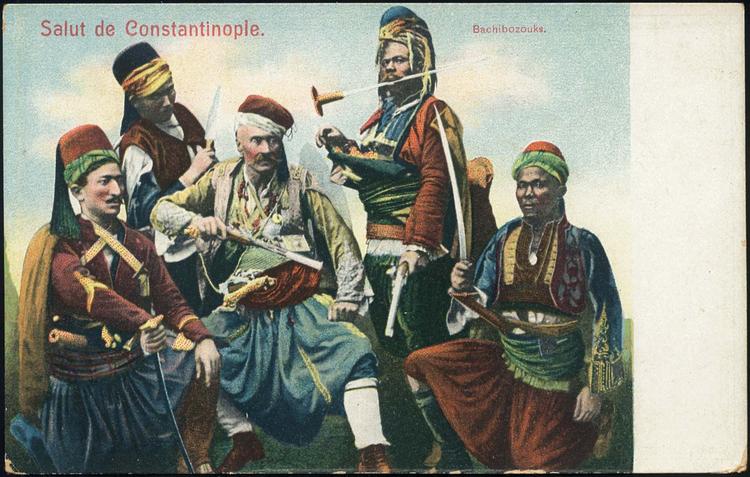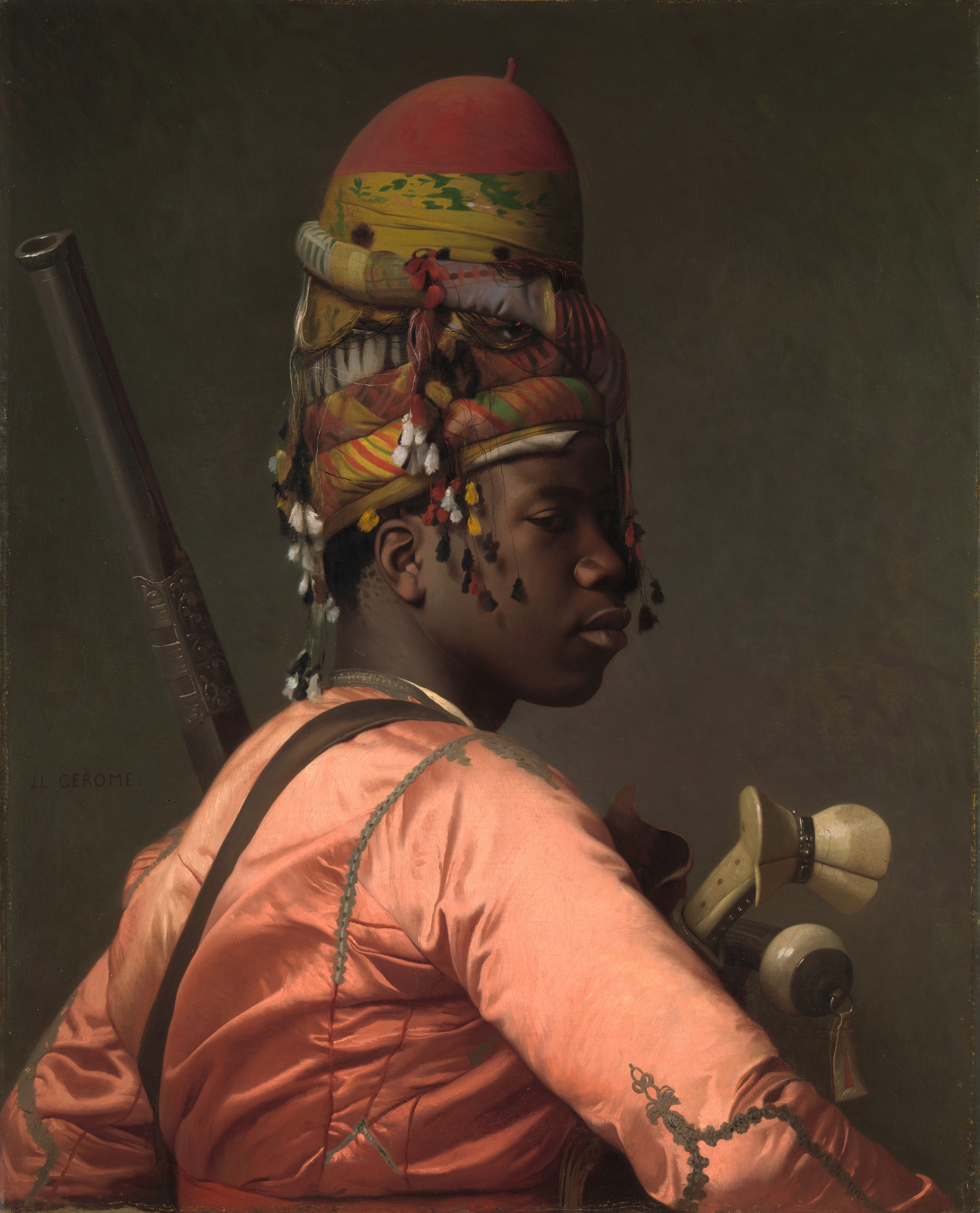Bashi-bazouk on:
[Wikipedia]
[Google]
[Amazon]

 A bashi-bazouk ( ota, باشی بوزوق , , , roughly "leaderless" or "disorderly") was an irregular military, irregular soldier of the Ottoman army, raised in times of war. The army chiefly recruited Albanians and Circassians as bashi-bazouks, but recruits came from all ethnic groups of the Ottoman Empire including slaves from Europe or Africa. They had a reputation for bravery, but also as an undisciplined and brutal group, notorious for looting and preying on civilians as a result of a lack of regulation and of the expectation that they would support themselves off the land.
A bashi-bazouk ( ota, باشی بوزوق , , , roughly "leaderless" or "disorderly") was an irregular military, irregular soldier of the Ottoman army, raised in times of war. The army chiefly recruited Albanians and Circassians as bashi-bazouks, but recruits came from all ethnic groups of the Ottoman Empire including slaves from Europe or Africa. They had a reputation for bravery, but also as an undisciplined and brutal group, notorious for looting and preying on civilians as a result of a lack of regulation and of the expectation that they would support themselves off the land.
File:Пиотровский. батакская резня. 1889 год.jpeg, Bashi-bazouks carrying out the Batak massacre.
File:Basibozuk-1877.jpg, Bashi-bazouks' atrocities in Ottoman Bulgaria.
File:Konstantin Makovsky - The Bulgarian martyresses.jpg, ''The Bulgarian Martyresses'' (1877), painting by Konstantin Makovsky depicting the rape of two Bulgarian women in a church by one African-looking and two Turkish-looking bashi-bazouks, during the April Uprising.
File:Chef arnaute by Jean-Léon Gérôme.jpg, An Albanian bashi-bazouk in Egypt. Painting by Jean-Léon Gérôme, 1870.
File:A Bashi-Bazouk, drawn by Francis Davis Millet.jpg, Drawing of a bashi-bazouk by Francis Davis Millet, 1889.
File:Jean-Léon Gérôme – Bachi-bouzouk Arnaoute.jpg, An Albanian bashi-bazouk painted by Jean-Léon Gérôme in the 1860s.
File:Vernet-Lecomte 7.jpg, A bashi-bazouk contemplating his loot. Painting by Émile Vernet-Lecomte, 1862.
File:Jean-Léon Gérôme - A Bashi-Bazouk.jpg, An African bashi-bazouk, painted by Jean-Léon Gérôme, 1860s.
File:Два ястреба (Башибузуки).jpg, Two captured bashi-bazouks, painted by Vasily Vereshchagin, 1878.

 A bashi-bazouk ( ota, باشی بوزوق , , , roughly "leaderless" or "disorderly") was an irregular military, irregular soldier of the Ottoman army, raised in times of war. The army chiefly recruited Albanians and Circassians as bashi-bazouks, but recruits came from all ethnic groups of the Ottoman Empire including slaves from Europe or Africa. They had a reputation for bravery, but also as an undisciplined and brutal group, notorious for looting and preying on civilians as a result of a lack of regulation and of the expectation that they would support themselves off the land.
A bashi-bazouk ( ota, باشی بوزوق , , , roughly "leaderless" or "disorderly") was an irregular military, irregular soldier of the Ottoman army, raised in times of war. The army chiefly recruited Albanians and Circassians as bashi-bazouks, but recruits came from all ethnic groups of the Ottoman Empire including slaves from Europe or Africa. They had a reputation for bravery, but also as an undisciplined and brutal group, notorious for looting and preying on civilians as a result of a lack of regulation and of the expectation that they would support themselves off the land.
Origin and history
Although the Ottoman armies always contained mercenaries as well as regular soldiers, the strain on the Ottoman feudal system caused mainly by the Empire's wide expanse required heavier reliance on irregular soldiers. They were armed and maintained by the government, but did not receive pay and did not wear uniforms or distinctive badges. They were motivated to fight mostly by expectations of plunder. Though the majority of troops fought on foot, some troops (called ''akinji, aḳıncı'') rode on horseback. Because of their lack of discipline, they were incapable of undertaking major military operations, but were useful for other tasks such as reconnaissance and outpost duty. However, their uncertain temper occasionally made it necessary for the Ottoman regular troops to disarm them by force. The Ottoman army consisted of the following: * The Sultan's household troops, called ''Kapikulu, Kapıkulu'', which were salaried, most notable being Janissary corps. * Provincial soldiers, which were fiefed (Turkish ''Timariot, Tımarlı''), the most important being ''Timarli Sipahi'' (lit. "fiefed cavalry") and their retainers (called ''cebelu'' lit. armed, man-at-arms), but other kinds were also present * Soldiers of subject, protectorate, or allied states (the most important being the Crimean Peninsula, Crimean Khans) * Bashi-bazouks, who usually did not receive regular salaries and lived off loot Many Afro-Turks, Crimean Tatars, Muslim Roma, and Pomaks were bashi-bazouks in Rumelia. An attempt by Koca Hüsrev Mehmed Pasha to disband his Albanian bashi-bazouks in favor of his regular forces began Muhammad Ali's seizure of power, the rioting which led to the establishment of Muhammad Ali of Egypt, Muhammad Ali's Khedivate of Egypt. The use of bashi-bazouks was abandoned by the end of the 19th century. However, self-organized bashi-bazouk troops still appeared later. The term "bashibozouk" has also been used for a mounted force, existing in peacetime in various provinces of the Ottoman Empire, which performed the duties of gendarmerie.Reputation and atrocities
The bashi-bazouks were notorious for being violently brutal and undisciplined, thus giving the term its second, colloquial meaning of "undisciplined bandit" in many languages. A notable example of this use is in the comic series ''The Adventures of Tintin'', where the word is often used as an insult by Captain Haddock. The Batak massacre (1876) was carried out by thousands of bashi-bazouks sent to quell a local rebellion. Likewise, bashi-bazouks perpetrated the massacres of Candia massacre, Candia and massacre of Phocaea, Phocaea in 1898 and 1914. During the 1903 Ilinden–Preobrazhenie Uprising, Ilinden-Preobrazhenie Uprising in Ottoman Macedonia, these troops burned 119 villages and destroyed 8400 houses, and over 50,000 Bulgarian refugees fled into the mountains.Depictions in art
See also
* Mercenary * Pindari, irregular horsemen in History of India, 18th-century India * Military of the Ottoman Empire * Military history of TurkeyReferences
Sources
* * *''Ottoman warfare'', 1500–1700 by Rhoads Murphey. London : UCL Press, 1999. *Özhan Öztürk (2005). ''Karadeniz'' (Black Sea): Ansiklopedik Sözlük. 2 Cilt. Heyamola Yayıncılık. İstanbul. . *Montgomery, Viscount Bernard (1968). ''A History of Warfare'', The World Publishing Company. . {{Albanians under the Ottoman Empire Turkish words and phrases Military units and formations of the Ottoman Empire Mercenary units and formations 19th century in the Ottoman Empire Robbers Outlaws Ottoman period in the Balkans Persecution of Christians in the Ottoman Empire